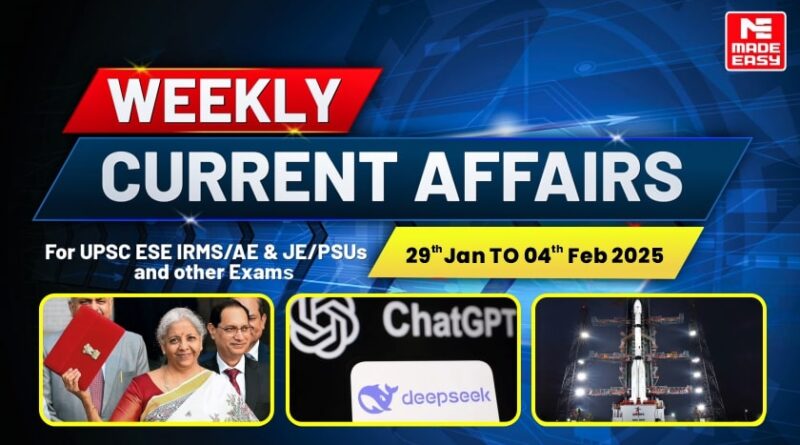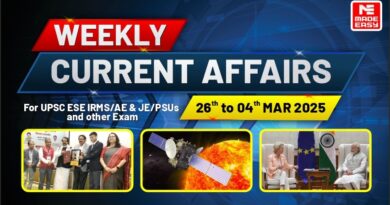Last Week Current Affairs: 29th JAN to 4th FEB 2025
MADE EASY Last Week Current Affairs: 29th JAN to 4th FEB 2025
Aspirants preparing for government exams in India often prioritize current affairs, as it is a crucial section in most exams. Whether the exam is technical or non-technical, authorities include current affairs questions to evaluate a candidate’s general awareness. Given its significance, dedicating time and effort to mastering this section can greatly enhance exam performance.
To simplify your exam preparation, MADE EASY brings you the latest MADE EASY Last Week Current Affairs to enhance your GS score. This comprehensive resource covers all significant national and international events in one place, helping aspirants stay updated while saving valuable preparation time.
In this edition of MADE EASY Last Week Current Affairs, you will read about: DeepSeek,Liquid Propulsion Systems of ISRO, Certificate of Origin (eCoO) 2.0 System, ISRO’s 100th Launch, When-Listed Platform, National Critical Mineral Mission (NCMM), Economic Survey 2024-25, Shubhanshu Shukla, Union Budget 2025-26, IndiaAI Mission Gyan Bharatam Mission, Samudrayaan Mission, Foreign Direct Investment (FDI), Ocean Coordination Mechanism, Makhana Board, GARBH-INi-DRISHTI, International Big Cat Alliance (IBCA) and much more!
Understanding these key topics will help you score well in your GS exam. Stay informed and boost your preparation with MADE EASY!
Top Headlines of the Week:
DeepSeek: 29 January 2025
Context: China has developed DeepSeek AI models, DeepSeek-V3 and DeepSeek-R1.
About DeepSeek
- DeepSeek is the name of a free AI-powered chatbot, developed by the Chinese AI company founded by entrepreneur Liang Wenfeng.
- This has emerged as strong contenders in the global AI landscape, performing on par with ChatGPT and other leading AI systems.
- How is it Different?
- It was built at a fraction of the cost of industry-leading models like OpenAI – because it uses fewer advanced chips.
- Its base model DeepSeek-R1 appears to have been trained via accurate sources while introducing a layer of censorship.
- It surpasses models developed by tech giants Google, Meta, and Anthropic in terms of overall quality.
- DeepSeek is also faster than GPT 4, more practical and, according to many experts, even understands regional idioms and cultural contexts better than its Western counterparts.
About Large Language Model (LLM)
- A Large Language Model (LLM) is a type of AI trained to understand and generate human language.
- These models are built on deep learning techniques allowing them to process and generate text in a coherent, contextually appropriate manner.
- LLMs are used for various tasks, including text generation, language translation, and summarization.
Liquid Propulsion Systems of ISRO: 29 January 2025
Context: Recently, ISRO appointed M. Mohan as director of Liquid Propulsion Systems Centre in Thiruvananthapuram.
About Liquid Propulsion Systems
- Liquid propulsion systems use liquid propellants, such as liquid oxygen (LOX) and liquid hydrogen (LH2), to generate thrust.
- These systems are preferred over solid propulsion systems due to their higher efficiency, controllability, and ability to be restarted multiple times.
About Liquid Propulsion Systems Centre (LPSC)
- It is a key facility under ISRO, responsible for the design, development, and realization of liquid propulsion stages for ISRO’s launch vehicles.
- It has two units located in Thiruvananthapuram (Valiamala) and Bengaluru, each focusing on different aspects of liquid propulsion systems.
Recent Developments
- Gaganyaan Mission: ISRO has integrated advanced liquid propulsion systems into the Crew Module for the first uncrewed mission of the Gaganyaan project. The Crew Module Propulsion System (CMPS) is a bi-propellant based Reaction Control System (RCS) designed for precise three-axis control (pitch, yaw, and roll) during the descent and re-entry phases.
- Cryogenic Upper Stage: ISRO has developed an indigenous cryogenic upper stage for the Geosynchronous Satellite Launch Vehicle (GSLV). It has significantly enhanced India’s capabilities in launching heavier payloads into space.
- Satellite Propulsion Systems: The LPSC is responsible for developing propulsion systems for satellites, including monopropellant thrusters and components for satellite control and maneuvering.
Certificate of Origin (eCoO) 2.0 System: 29 January 2025
Context: The Directorate General of Foreign Trade (DGFT) has launched the enhanced Certificate of Origin (eCoO) 2.0 System.
Key Highlights
- It is designed to simplify the certification process for exporters and enhance trade efficiency.
- It offers multi-user access, which enables exporters to authorize multiple users under a single Importer Exporter Code (IEC).
- It offers exporters seamless access to eCoO services, Free Trade Agreement (FTA) information, trade events, and other resources.
- Significance:
- These certificates cater to goods not of Indian origin, intended for re-export, trans-shipment, or merchanting trade.
- This initiative not only simplifies the certification process but also accelerates processing times, making it particularly beneficial for global supply chains involving intermediary trade through India.
ISRO’s 100th Launch: 30 January 2025
Context: The Indian Space Research Organisation (ISRO) launched its historic 100th launch from the Satish Dhawan Space Centre in Sriharikota.
Key Highlights
- GSLV F15 carried the NVS-02 navigation satellite placing it into a Geosynchronous Transfer Orbit.
- The NVS-02 is the second satellite in the NVS series, and part of India’s Navigation with Indian Constellation (NavIC).
- It is designed to provide accurate positioning services across India.
- GSLV-F15 is the 17th flight of India’s Geosynchronous Satellite Launch Vehicle (GSLV) and 11th flight with Indigenous Cryo stage.
- Over these 100 launches ISRO has lifted 548 satellites to orbit.
About Geosynchronous Transfer Orbit
The GTO allows satellites to be positioned into geostationary orbits, where they can maintain a fixed position relative to the Earth’s surface.
This is crucial for communication and weather satellites that need to monitor specific areas continuously.
About NavIC
- It is a regional navigation satellite system established by Indian Space Research Organisation (ISRO).
- NavIC was erstwhile known as Indian Regional Navigation Satellite System (IRNSS).
- NavIC is designed with a constellation of 7 satellites and a network of ground stations operating 24 x 7.
- Three satellites of the constellation are placed in geostationary orbit and four satellites are placed in inclined geosynchronous orbit.
- The ground network consists of a control centre, precise timing facility, range and integrity monitoring stations, two-way ranging stations, etc.
- NavIC offers two services: Standard Position Service (SPS) for civilian users and Restricted Service (RS) for strategic users.
- It provides location accuracy better than 20 meters and timing accuracy better than 40 nanoseconds across the core service area.
- The NavIC coverage area includes India and a region up to 1,500 kmbeyond the Indian boundary.
- NavIC SPS signals are interoperable with the other global navigation satellite system (GNSS) signals namely GPS, Glonass, Galileo and BeiDou.
When-Listed Platform: 30 January 2025
Context: The “when-listed” platform proposed by SEBI is a significant regulatory initiative aimed at curbing grey market trading and ensuring a transparent and structured mechanism for trading IPO shares before their official listing.
About Grey Market
- The grey market refers to the unofficial trading of securities, particularly shares, before they are officially listed on stock exchanges.
- It operates outside the regulatory framework, relying on demand and supply dynamics.
- Here, the transactions are based on notional prices (prices agreed upon informally, without the actual transfer of shares until listing), and no physical delivery of shares occurs here.
Key Aspects of the “When-Listed” Platform
- Regulated Pre-Listing Trading: This platform will allow investors to trade IPO shares after allotment but before official listing, bridging the gap between T+1 (allotment day) and T+3 (listing day).
- Price Discovery Before Listing: The “when-listed” price may serve as a pre-listing indicator of how the stock might perform on the listing day. Helps in better investment decisions for both retail and institutional investors.
- Shorter Settlement Periods (T+0, T+1): This aligns with SEBI’s broader push toward faster trade settlements, such as the recent introduction of the T+0 settlement cycle for select stocks.
National Critical Mineral Mission (NCMM): 30 January 2025
Context: The Union Cabinet has approved the launch of the National Critical Mineral Mission (NCMM) with an expenditure of ₹16,300 crore.
Key Facts
- Aim: To create a fast-track regulatory approval process for critical mineral mining projects.
- The NCMM will encompass all stages of the value chain, including mineral exploration, mining, beneficiation, processing, and recovery from end-of-life products.
- Features:
- Setting up mineral processing parks and supporting the recycling of critical minerals.
- Promote research in critical mineral technologies and proposes setting up Centre of Excellence on Critical Minerals.
- It also proposes development of a stockpile of critical minerals within the country.
- It encourages Indian PSUs and private sector companies to acquire critical mineral assets abroad and enhance trade with resource-rich countries.
About Critical Minerals
- Critical minerals are those minerals that are essential for economic development and national security.
- The future global economy will be underpinned by technologies that depend on minerals such as lithium, graphite, cobalt, titanium, and rare earth elements.
- These are essential for the advancement of many sectors, including high-tech electronics, telecommunications, transport, and defence.
Economic Survey 2024-25: 31 January 2025
Context: Union Minister of Finance and Corporate Affairs, Nirmala Sitharaman presented the Economic Survey 2024-25 in the Parliament.
About Economic Survey
- The Economic Survey is a comprehensive review of the country’s current economic state and future outlook.
- It is prepared by the Economic Division of the Department of Economic Affairs under the guidance of the Chief Economic Advisor.
Major Highlights
- State of the Economy: India’s real GDP growth estimated at 6.4% in FY25, aligning with its decadal average.
- Global GDP grew 3.3% in 2023, slightly higher than IMF’s 3.2% forecast for the next five years.
- FY26 GDP growth expected between 6.3% and 6.8%.
- Retail inflation reduced to 4.9% in FY25 (April-Dec).
- Capital expenditure (CAPEX) grew 8.2% YoY post-general elections in 2024.
- India’s share in global services exports is 7th largest.
- Monetary and Financial Sector Developments: Bank credit grew steadily; asset quality and profitability improved.
- Gross non-performing assets (GNPAs) at a 12-year low (2.6% of gross loans).
- ₹3.6 lakh crore realized from 1,068 insolvency resolutions.
- India’s stock markets outperformed emerging market peers.
- Resource mobilization from primary markets reached ₹11.1 lakh crore in FY25.
- Insurance premiums grew by 7.7%, and pension sector subscribers rose 16%.
- External Sector: Exports grew by 6%, with the services sector up 11.6% (April-Dec FY25).
- India ranked 2nd in global telecommunications, computer & information services exports.
- FDI inflows increased by 17.9% YoY to USD 55.6 billion in FY25.
- Forex reserves stood at USD 640.3 billion, covering 10.9 months of imports.
- Prices and Inflation: Global inflation moderated to 5.7% in 2024.
- India’s retail inflation reduced to 4.9% in FY25.
- RBI and IMF project inflation will align to around 4% by FY26.
- Medium-Term Outlook: India aims for 8% growth to achieve ‘Viksit Bharat’ by 2047.
- Focus on deregulation to empower growth and ease of doing business, particularly for SMEs.
- Investment and Infrastructure: Government capital expenditure grew by 38.8% from FY20 to FY24.
- 5853 km of National Highways constructed in FY25 (Apr-Dec).
- Renewable energy capacity grew by 15.8% YoY by Dec 2024.
- Significant infrastructure projects, including metro expansion and electricity access for rural areas.
- Industry: Industrial growth projected at 6.2% in FY25, driven by electricity and construction.
- Automobile sales up by 12.5% in FY24.
- India ranks 6th in global patent filings.
- The MSME sector is growing, with initiatives like the Self-Reliant India Fund.
- Services: Services sector contribution to GVA increased to 55.3% in FY25.
- Services exports grew by 12.8% in FY25 (Apr-Nov).
- Indian Railways and tourism sector show strong growth.
- Agriculture and Food Management: Agriculture contributes 16% to GDP in FY24.
- Kharif foodgrain production is expected to rise by 89.37 LMT in FY24.
- Fisheries and livestock sectors show strong growth.
- MSP increases for Arhar and Bajra by 59% and 77%, respectively.
- Kharif foodgrain production is expected to rise by 89.37 LMT in FY24.
- Climate & Environment: India’s non-fossil fuel power generation capacity reached 46.8% of total capacity.
- LiFE initiative to drive sustainable living, with potential global savings of USD 440 billion by 2030.
- India’s carbon sink increased by 2.29 billion tonnes CO2 equivalent.
- Social Sector: Social services expenditure grew at 15% CAGR from FY21 to FY25.
- Decline in income inequality, with improvements in rural and urban Gini coefficients.
- Government health expenditure up from 29% to 48%, reducing out-of-pocket expenses.
- Ayushman Bharat has saved over ₹1.25 lakh crore.
- Employment and Skill Development: Unemployment rate declined to 3.2% in FY24.
- Government initiatives supporting women entrepreneurship, including credit and skill development.
- Emerging sectors like the digital economy and renewable energy provide job opportunities.
- EPFO payroll additions doubled in the last six years.
- Labour in the AI Era: AI expected to surpass human performance in key sectors but faces barriers like reliability and infrastructure.
- India’s young, tech-savvy population is poised to leverage AI for enhanced productivity.
- Collaboration between government, private sector, and academia is crucial to manage AI’s societal impact.
Shubhanshu Shukla: 31 January 2025
Context: ISRO astronaut Shubhanshu Shukla will serve as a pilot on the Axiom Mission 4 to the International Space Station (ISS).
Key Highlights
- He will be the first Indian astronaut to reach the International Space Station (ISS) on a private mission.
- He became only the second Indian to go to space after Wing Commander Rakesh Sharma in 1984.
- He is elected as an astronaut-designate for India’s Gaganyaan mission (tentatively scheduled for 2026).
About Axiom Mission-4
- Axiom Mission 4 (or Ax-4) is a private spaceflight to the International Space Station to be launched in April 2025.
- Duration: Up to 14 days.
- Countries: USA, India, Poland, and Hungary.
- It is the first government-sponsored spaceflight in over 40 years for Poland & Hungary.
- Objectives: The astronauts will execute a mission that includes outreach, scientific, and commercial operations during their 14-day stay in orbit.
Union Budget 2025-26: 1 February 2025
Context: The Union Budget 2025-26 was framed around the theme “Sabka Vikas,” emphasizing balanced growth across all regions of India.
Key Highlights
- The Union Finance Minister quoted the renowned Telugu poet Shri Gurajada Appa Rao’s saying, “A country is not just its soil; a country is its people,” to highlight the importance of people-centric development.
- Principles of Viksit Bharat:
- Eradicate poverty (Zero-poverty)
- Provide high-quality, universal school education
- Ensure access to affordable, comprehensive healthcare
- Achieve full employment with a skilled workforce
- Involve 70% women in economic activities
- Strengthen agriculture to make India the “food basket of the world
Budget Estimates 2025-26
- The total receipts other than borrowings and the total expenditure are estimated at ₹ 34.96 lakh crore and ₹ 50.65 lakh crore respectively.
- The net tax receipts are estimated at ₹ 28.37 lakh crore.
- The fiscal deficit is estimated to be 4.4 per cent of GDP.
- The gross market borrowings are estimated at ₹ 14.82 lakh crore.
- Capex Expenditure of ₹11.21 lakh crore (3.1% of GDP) earmarked in FY2025-26.
Key Engines of Growth
- Agriculture (1st Engine): Launch of Prime Minister Dhan-Dhaanya Krishi Yojana to cover 100 districts.
- Mission for Aatmanirbharta in Pulses for Tur, Urad, and Masoor pulses.
- Loan limit for Kisan Credit Cards raised from ₹3 lakh to ₹5 lakh.
- Comprehensive program for vegetables, fruits, high-yield seeds, and cotton productivity.
- MSMEs (2nd Engine): MSME investment & turnover limits enhanced to 2.5 and 2 times.
- Credit cards for micro enterprises and a loan scheme for 5 lakh women and marginalized entrepreneurs.
- Development of a toy manufacturing hub and National Manufacturing Mission.
- Investment (3rd Engine): 50,000 Atal Tinkering Labs to be set up in schools.
- Broadband for all secondary schools & PHCs under BharatNet project.
- Establishment of National Centres of Excellence for skilling.
- ₹1.5 lakh crore for 50-year interest-free loans to states for capital expenditure.
- Urban Challenge Fund of ₹1 lakh crore to support urban development.
- ₹20,000 crore for private sector-driven R&D and innovation.
- National Geospatial Mission for urban planning and Gyan Bharatam Mission for manuscript conservation.
- Nuclear Energy Expansion: ₹ 20,000 crore for Small Modular Reactors (SMRs).
- Exports (4th Engine): Launch of Export Promotion Mission and BharatTradeNet for trade documentation.
- Support for domestic manufacturing and integration with global supply chains.
- Infrastructure support for air cargo and fisheries exports.
Reforms
- Financial Sector: Increase in FDI limit in insurance from 74% to 100%.
- Establishment of a High-Level Committee for Regulatory Reforms.
- Introduction of the Investment Friendliness Index of States.
- Decriminalization of 100+ provisions under the Jan Vishwas Bill 2.0.
- Financial Stability and Development Council (FSDC) to review regulations.
- Taxation & Fiscal Policy: Fiscal deficit target of 4.4% of GDP for FY 2025-26.
- Increased receipts and expenditure estimates for 2025-26.
- Commitment to fiscal consolidation with a clear roadmap.
Tax Proposals
- Personal Income Tax Reform: no tax for income up to ₹12 lakh per annum.
- Standard deduction of ₹75,000 for income up to ₹12.75 lakh.
- Estimated ₹1 lakh crore revenue loss due to tax reforms.
- TDS/TCS Rationalization: TDS limit on interest for senior citizens increased from ₹50,000 to ₹1 lakh.
- TDS threshold on rent raised to ₹6 lakh from ₹2.4 lakh.
- Extension of updated returns filing to 4 years for any assessment year.
- Compliance Simplification: Increase in registration period for small charitable trusts from 5 to 10 years.
- Senior citizens benefit from tax exemption on National Savings Scheme withdrawals.
- Promotion of Employment & Investment: Presumptive taxation regime for non-residents providing services to electronics manufacturing companies.
- Extension of the Sovereign Wealth Funds and Pension Funds investment deadline to 2030.
- Customs Tariff Reforms: Removal of seven tariffs, simplification of cess, and reduction of Basic Customs Duty (BCD) on critical minerals and textiles.
- Reduction in BCD on lithium-ion battery manufacturing capital goods and shipbuilding materials.
- Duty adjustments to encourage domestic manufacturing.
- Export Promotion: Reduction of BCD on fish products and leather to boost exports.
- Fully exempted BCD on lifesaving medicines for cancer, rare diseases, and chronic illnesses.
IndiaAI Mission: 1 February 2025
Context: The Indian government has decided to build a domestic large language model of its own as part of the ₹10,370 crore IndiaAI Mission.
Key Highlights
- It aims to build a homegrown AI system that understands India’s unique culture, languages, and needs.
- The foundational model could take anywhere between 4-8 months.
- The government’s AI compute facility would be “the most affordable” in the world.
- Infrastructure:
- The government has selected 10 companies that will supply 18,693 graphics processing units or GPUs.
- GPUs are high end chips needed to develop machine learning tools that can go into developing a foundational model. GPUs have become essential for more complex tasks, such as large-scale data processing and cryptocurrency mining.
- The project also includes plans for AI data centres in Odisha.
- The idea is that institutions and researchers use GPUs and bring in innovations.
- Since these GPUs are available now, students and researchers can make models on a large-scale instead of working in an ad hoc manner.
About IndiaAI Mission
- Over the next five years, it will support the initiatives like the IndiaAI Compute Capacity, IndiaAI Innovation Centre (IAIC), IndiaAI Datasets Platform, IndiaAI Application Development Initiative, IndiaAI FutureSkills, IndiaAI Startup Financing, and Safe & Trusted AI.
- Aim:Establishing a public-private partnership model aimed at nurturing India’s AI innovation ecosystem.
- These initiatives aim to bolster India’s global leadership in AI (Artificial intelligence), foster technological self-reliance, ensure ethical and responsible AI deployment, and democratize the benefits of AI across all strata of society.
Gyan Bharatam Mission: 2 February 2025
Context: The Gyan Bharatam Mission was announced in the Union Budget 2025-26.
Key Highlights
- It is a landmark initiative focused on the survey, documentation, and conservation of India’s manuscript heritage.
- The mission aims to cover more than one crore manuscripts, ensuring their preservation and accessibility for future generations.
- With this initiative, the government is taking significant steps to reviving the National Manuscripts Mission (NMM) launched in 2003 but largely inactive, and promoting India’s rich literary and intellectual traditions at a global level.
- To accommodate this initiative, the budget for the National Manuscripts Mission (NMM) has been significantly increased from ₹3.5 crore to ₹60 crore.
Significance of the Mission
- Preserving India’s Intellectual and Cultural Heritage: Manuscripts hold knowledge on subjects such as philosophy, science, medicine, literature, mathematics, and astronomy. Their preservation helps safeguard India’s historical wisdom.
- Digital Access for Future Generations: Manuscripts often suffer from physical decay. Digitization ensures 24/7 access to these texts worldwide while preventing deterioration.
- Global Academic Impact: By making manuscripts available for study, India strengthens its position as a hub of ancient knowledge and scholarship.
Samudrayaan Mission: 2 February 2025
Context: Samudrayaan Mission has been allocated Rs 600 crore in Union Budget 2025-26.
Key Highlights
- Launched in 2021, it is India’s first manned ocean mission to explore the deep ocean.
- It is a project of the Ministry of Earth Sciences (MoES) under the Deep Ocean Mission.
- The technology is being developed by the National Institute of Ocean Technology (NIOT).
- NIOT is an autonomous institute under MoES, has developed a 6000m depth-rated Remotely Operated Vehicle (ROV) ‘Matsya 6000’.
- The mission aims to send three people to a depth of 6,000 meters in a submersible called the MATSYA 6000.
- The submersible will have an operational endurance of 12 hours, which is extendable up to 96 hours in the event of an emergency.
- Objectives of the Mission:
- To study deep-sea marine life.
- To explore the distribution of polymetallic nodules, which are rich in minerals such as copper, nickel, and cobalt.
- To study the impact of climate change on the ocean.
- To develop India’s capabilities in deep-sea exploration and research as well as develop underwater vehicles and underwater robotics.
- To develop offshore-based desalination techniques, renewable energy generation techniques, and provide clean drinking water and explore the avenues of desalination of water.
- So far, countries such as the U.S., Russia, China, France and Japan have carried out successful deep-ocean crewed missions.
Foreign Direct Investment (FDI): 3 February 2025
Context: Finance Minister Nirmala Sitharaman announced the opening up of the insurance sector to 100% foreign direct investment (FDI), up from the previous limit of 74%, to boost the sector.
Indian Insurance Sector
- It has undergone significant transformation, evolving from being dominated by Life Insurance Corporation (LIC) to a more diverse industry with various players offering a wide range of products.
- The transformation has been driven by Economic development, Technological advancements, Demographic changes, Increased consumer awareness, particularly after the COVID-19 pandemic, regarding the importance of financial security through insurance.
- The insurance sector has played a significant role in the economic development of India.
Impact of 100% FDI on Insurance
- India’s insurance sector has attracted Rs 82,847 crore in FDI since 2000, driving growth and improving operations.
- The government expects the sector to grow at 7.1% annually over the next five years, driven by foreign investment and policy changes.
- 100% FDI could address the insurance under-penetration in India, accelerating the adoption of global best practices and introducing innovative products and services.
- It will ensure long-term capital, enhance technology, strengthen distribution, and increase competitiveness.
Ocean Coordination Mechanism: 3 February 2025
Context: The Ocean Coordination Mechanism (OCM) is a new initiative for ocean conservation.
Key Highlights
- Announced by Intergovernmental Oceanographic Commission (IOC) of UNESCO on January 14, 2025.
- Focuses on the Caribbean and North Brazil shelf, which are rich in biodiversity, coral reefs, and fisheries.
- Objectives: Establishes a collaborative framework for ocean conservation.
- Builds on lessons from past initiatives like Pacific Islands Regional Ocean Policy (PIROP).
- Addresses financial sustainability with an initial $15 million investment from Global Environment Facility (GEF), plus $126.02 million in co-financing.
- Promotes Blue Carbon Projects to enhance carbon storage and ecosystem resilience.
- Integrates traditional knowledge with scientific research for community-driven conservation efforts.
Makhana Board: 3 February 2025
Context: The Union Budget 2025-26 has allocated ₹100 crore to establish a Makhana Board in Bihar, aimed at promoting Makhana products. The Board will provide training, support, and access to government schemes to benefit Makhana farmers.
About Makhana
- Common Name: Fox nut
- Botanical Features: Recognized for its violet and white flowers.
- Has large, round, and prickly leaves, often exceeding one meter in diameter.
- Nutritional & Economic Importance: Considered a superfood, rich in carbohydrates, protein, and minerals.
- Widely used in medicine, healthcare, and nutrition.
- Mithila Makhana received the Geographical Indication (GI) tag in 2022.
- Cultivation: Cultivated across South and East Asia, with Bihar contributing nearly 90% of global production.
- Major Producing Districts in Bihar: Darbhanga, Madhubani, Purnea, Katihar, Saharsa, Supaul, Araria, Kishanganj, and Sitamarhi (Mithilanchal region).
- Climatic & Agronomic Conditions: Grown in tropical and subtropical regions.
- Cultivated in stagnant water bodies like ponds, lakes, and wetlands (depth: 4-6 feet).
- Optimal Growth Conditions:
- Temperature: 20-35°C
- Humidity: 50-90%
- Annual Rainfall: 100-250 cm
GARBH-INi-DRISHTI: 4 February 2025
Context: The Department of Biotechnology has launched the GARBH-INi-DRISHTI data repository.
Key Highlights
- GARBH-INi-DRISHTI is the Data Repository and Information Sharing Hub at Translational Health Science and Technology Institute (THSTI). It provides access to clinical data, images, and biospecimens collected from over 12,000 pregnant women, newborns, and postpartum mothers.
- Significance: As one of South Asia’s largest maternal and child health databases, GARBH-INi-DRISHTI will empower researchers worldwide to conduct transformative research aimed at improving maternal and neonatal health outcomes.
- THSTI: The newly inaugurated THSTI Ferret Research Facility, is a state-of-the-art establishment adhering to the highest biosafety and research standards.
- It will serve as a crucial resource for vaccine development, therapeutic testing, and research into emerging infectious diseases.
International Big Cat Alliance (IBCA): 4 February 2025
Context: The Framework Agreement on the establishment of the International Big Cat Alliance (IBCA) recently came into force, making it a full-fledged, treaty-based inter-governmental international organization.
About International Big Cat Alliance (IBCA)
- The IBCA was launched by Prime Minister Narendra Modi in 2023, during the “Commemorating 50 years of Project Tiger” event. It is headquartered in Delhi.
- Members: 27 countries have consented to join the Alliance.
- Five countries (Nicaragua, Eswatini, India, Somalia, and Liberia) have officially ratified and become members of the IBCA.
- It was established by the Government of India through the National Tiger Conservation Authority (NTCA), Ministry of Environment, Forest & Climate Change (MoEFCC), with an order dated 12th March, 2024.
- It aims to conserve seven big cat species: Tiger, Lion, Leopard, Snow Leopard, Cheetah, Jaguar, and Puma. It includes both range countries (countries where these species are found) and non-range countries interested in supporting big cat conservation.
- The primary goal of IBCA is to facilitate global collaboration for big cat conservation, consolidate successful conservation practices, and achieve the common goal of preserving big cats worldwide.
- It aims to provide financial support, disseminate conservation best practices, create a central repository of technical knowledge, and strengthen intergovernmental conservation platforms.
To read all the current affairs of the last year, click on the link below:
🔗Download the Complete Current Affairs PDF for Free Now!
Must Read: 🔗 GS Score Weekly Current Affairs: 15 to 21 JAN 2025
MADE EASY Offline and Online Courses
| MADE EASY Classroom & Live-Online Courses: Enroll Now 👇 | |
|---|---|
Classroom Courses |
|
| GATE | GATE+ESE |
| GATE+SES | GATE+ESE+SES |
| Conventional Course | Offline Test Series |
| G.S. & Engg. Aptitude Batch | Interview Guidance |
Live-Online Courses |
|
| GATE+SES | GATE+ESE |
| GATE+ESE+SES | JE & AE |
| Rank Improvement Course | RRB-JE |
| UPPSC-AE | State Exams (GS) Course |
Are you looking for Current Affairs 2024?
If yes then buy the book given below today and strengthen your exam preparation.
- Book Name: Current Affairs Quarterly Issue: July-August-September 2024
- Publisher Name: MADE EASY Publications
- MRP: ₹ 200.00
- Price: ₹ 170.00 (15% OFF)





